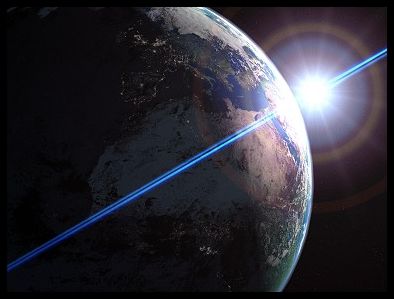

|
Astronomy 161
An Introduction to Solar System Astronomy
Prof. Scott Gaudi
|
Lecture 46:
The Search for Life in the Universe
Key Ideas:
A Habitable Planet is Defined By:
- Its distance from its parent star (Habitable Zone)
- Is size
Stars with rocky planets in their habitable zones are the best places to look for life
Planets are hard to find
- Radial velocity method has discovered the most planets
- Gravitational lensing method has found a solar system analog, suggests such systems are common.
Detecting life on other planets
- Spectra allow us to detect signatures of life on distance planets
Habitable Zone
The range of distances from the Sun, or more generally the parent star, where
liquid water can be stable on the surface (with the appropriate atmosphere).
Inner edge of the habitable zone:
- Venus (a=0.72 AU) is clearly too close.
- "Runaway Greenhouse" closer than a=0.84 AU
- 0.95 AU may be too close as well, but this is less certain.
Outer edge of the habitable zone:
- Is Mars too far? No:
- A thick carbon dioxide atmosphere could support liquid water out to 1.7 AU
- Beyond 1.7 AU, water will freeze regardless of the atmosphere.
Habitable zone: 0.84-1.7 AU (for the Sun!)
Size of the Planet
Too small:
- Surface gravity is too low, gasses will escape.
- Cools too quickly, loses magnetic field.
- Mars is an example of a planet in the habitable zone that is too small.
Too big:
- Will collect large amounts of H and He, will be too hot or too high pressure
- No example in the solar system.
Planet size limits: About 0.2 Earth Masses to 10 Earth Masses.
The "Goldilocks" Principle
Planets with a=0.84-1.7 AU and masses between 0.2 - 10 Earth masses are
'just right' in terms of their physical properties enabling liquid water on the
planet over a long time scale.
So where are the best places to look for life?
Stars with rocky, Earth-sized planets in their habitable zones are the best places to look for life
Planets are very small compared to their parent stars
Mass:
- Jupiter/Sun ~ 0.1%
- Earth/Sun ~ Three millionths
Radius:
- Jupiter/Sun ~ 10%
- Earth/Sun ~ 1%
Luminosity:
- Jupiter/Sun ~ Three billionths
- Earth/Sun ~ One billionth
Detecting Exoplanets
Direct Detection:
- Detect light (reflected or thermal) from the planet directly
Indirect Detection:
- Detect the planet through an indirect effect on the star or,
- Detect the planet through some effect not associated with light from the planet
Doppler Method
Detect the change in velocity of the primary star due to the indirect effect of the
star orbiting around the center of mass of the planet-star system.
Doppler Method:
- First discovery in 1995 (Mayor and Queloz)
- Has found the majority of the known planets
Known Extrasolar Planets:
- Around 250 planets known around other stars.
- Most from the Doppler method
- Most have masses of Saturn or greater
- Most are single-planet systems
- A number of multiple-planet systems have turned up
Solar systems?
- Most techniques not sensitive to systems like ours.
- Gravitational microlensing is.
- Has discovered a Jupiter/Saturn analog, suggesting that solar systems like ours are common.
Pale Blue Dots
What is the ultimate goal?
Direct Detection of Earthlike Planets
- Measurement of light is very powerful
Determining the properties of the planets
- Spectra allow the detection of atmospheric composition
- Spectra also allow the detection of biomarkers (signs of life)
Features in Earth's Spectrum
The Earth's spectrum has many different features, but the most important in this
context are:
- Water
- Oxygen (molecular and ozone)
- Carbon Dioxide
- Methane
The spectrum of unresolved Earthlike planets may indicate
the habitability of the planet or even the presence of life!
Return to [
Unit 7 Index
|
Astronomy 161 Main Page
]
Copyright © B. Scott Gaudi,
All Rights Reserved.

